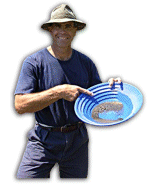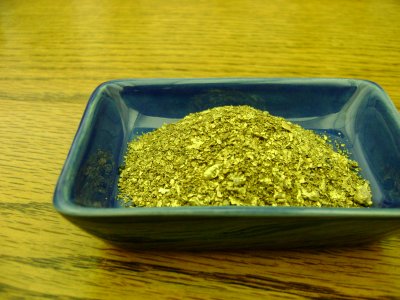
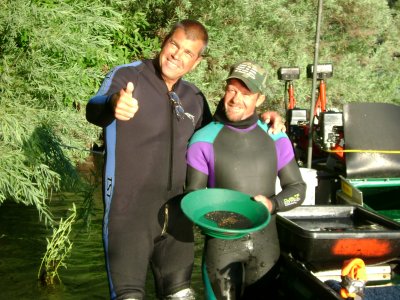
Note: Oregon Now Has Placed a Moratorium on Motorized Prospecting!
When Mark Chestnut, Jim Yerby and I teamed up with our dredges on the Rogue River this season, we had two main objectives in mind: The first was to sample aggressively in an attempt to locate entirely new high-grade areas along the river. The second objective was to invite other New 49″er members to dredge in the high-grade areas, especially as we move on with more sampling. I figure it helps others a lot as we establish exactly where the gold path is traveling down different segments of the river, and where gold is concentrating along the path.
Jim, Mark and I have not been the only team aggressively sampling the Rogue this season. Scott Baker from Colorado has been helping a bunch of other members stay in gold. There is another experienced guy (Tom) who fabricated a unique dredge inside of a river jet boat. Tom can just drive his dredge to where he wants to look for gold! He also has been turning pay-streaks over to others as he has moved forward in search of richer areas.
I have been making the rounds in my jet boat, and have been very pleased at how most members are freely passing helpful information to each other. There is a lot of teamwork going on! And there is a lot of gold being found. Here follows some video of one member telling me that he and others are doing well, just as I was floating by in my boat:
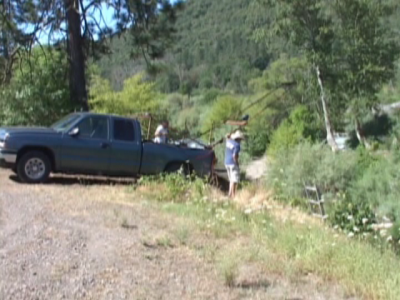 With gold at $1,680 as I write this, I suppose we are likely to see all kinds of interesting things going on. Jim and I came across a local miner who was in the process of lowering a 5-inch dredge over the side of a 30-foot drop using a special winching boom that he fabricated on the back of his pick-up truck. The miner was following up on an old story he heard about someone else finding gold down there. The thing that amazed me was how easily the dredge went over the side! We captured some of the action in the following video sequence:
With gold at $1,680 as I write this, I suppose we are likely to see all kinds of interesting things going on. Jim and I came across a local miner who was in the process of lowering a 5-inch dredge over the side of a 30-foot drop using a special winching boom that he fabricated on the back of his pick-up truck. The miner was following up on an old story he heard about someone else finding gold down there. The thing that amazed me was how easily the dredge went over the side! We captured some of the action in the following video sequence:
This has been a higher-water season (and faster) than normal on the Rogue River. Although, the river has been dropping steadily and is easier to dredge than it was several weeks ago. Even now, the river remains higher than it was at the beginning of last season. Higher, faster water has made it more difficult for us to sample out in the middle of the river. As I explained in my last report, these more difficult conditions prompted Mark and me to come up with a new “swing line“ idea to extend our suction hoses out into the middle. This has been working pretty well.
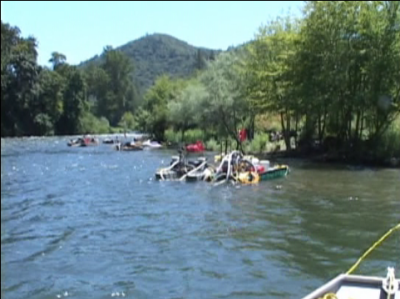
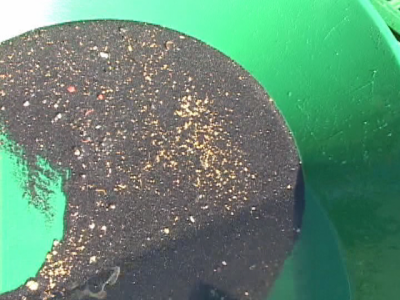
We thought we were going place all the fast water challenges behind us several weeks ago when we received an invitation from Scott Baker to share a hot new pay-streak that he had just discovered in a slower section of the river. Unfortunately for Mark and me, we were just going into a weekend high-banking project on our properties near Happy Camp. So we were not able to move our dredges to Scott”s new discovery until Monday morning. By then, there was a full gold rush in play. I gather that Scott kindly invited all the New 49″er members staying in his RV Park (in Gold Hill) to join him. So when Mark and I arrived, a bunch of others had already moved in, some recovering as much as an ounce of gold per day. The following video segment captures some of the action and excitement that remains in full play-mode as I write this:
Mark and I had been busy dredging a pay-streak (deep, fast water) that we had located about a mile downstream. Preferring to try something easier, we transferred our 5-inchers into the area near Scott”s discovery and took a shot at getting into the action. The problem for me was that the richest part of the pay-streak was located under a deposit of sand. I am running a double-screen recovery system on my dredge. It is the best thing I have ever seen on a suction dredge for recovering fine gold. But it chokes up (packs solid) if I pump sand. So Mark, Jim and I decided to allow these other members to enjoy their gold rush; and we moved on.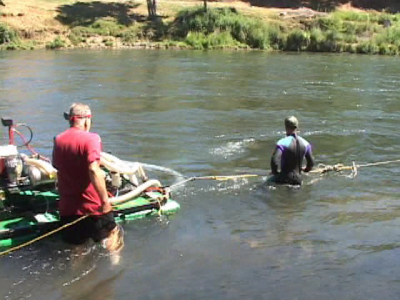
This following video segment caught us knocking out a few samples downstream of where the gold rush was happening. The gold there was pretty good, but not as good as what we were looking for:
Seeing all the gold that others were getting in such an easy location prompted Mark, Jim and I to do some more sampling. Most of this upper Rogue River area (about 40 miles) belongs to the State and is open to us for suction dredging. But a lot of it is land-locked by private property. Still, there are public access points regularly placed along the river. So a big part of our sampling program has been in working out how to use boats to move gear between the access points. Some members are using jet skis for this. We have gotten pretty good at it; especially at lowering our dredges down through fast rapids! Here follows a video segment which Jim Yerby shot that shows our dredge-moving routine. He should get some kind of award for holding the camera steady as we descended through some pretty rough water. Check it out:
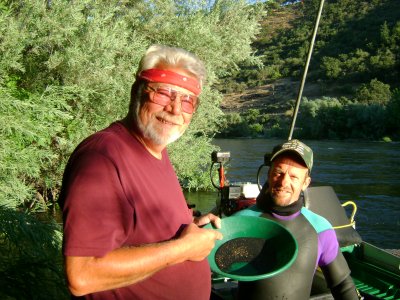
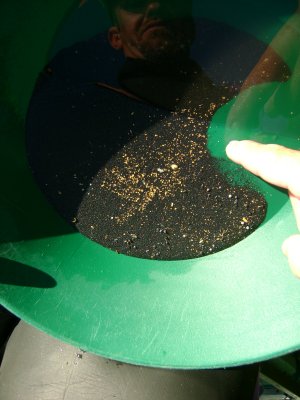
Mark, Jim and I have devoted the last two weeks in the section of the Rogue just downstream from where the Gold Ray dam was removed last fall. Our samples turned up a pay-streak on the north side of the river there and we have dropped back (once again) into the faster-water, lower portion of the pay-streak.
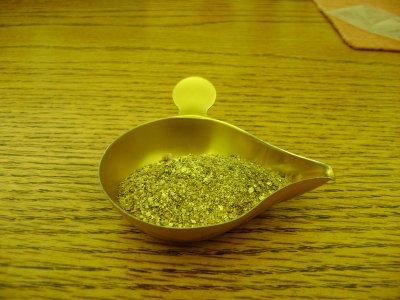
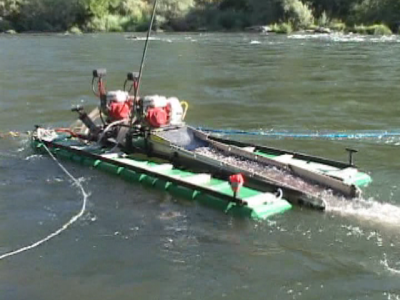
Here follow two video segments which demonstrate the careful, step-by-step process which we follow to establish the left and right boundaries of a fine-gold pay-streak once we find one:
This is surely the best pay-streak we have found so far this season. Here is a video segment which captured our enthusiasm when we saw how the gold was adding up in our sluice box:
There is money to be made in this pay-streak. So Mark is going to stay and work it for a while. We have also invited other members to move in. I have my eye on another stretch further downstream where I believe there are larger nuggets. I promised Jim Yerby some nice nuggets this season in exchange for all his help. So Jim and I will continue our sampling down that way. Our adventure is just beginning!
California has Extended its Moratorium on Suction Dredging!
As many of you will already know, on July 26, Governor Brown delivered another disappointment for gold miners across California by signing Assembly Bill 120, the Natural Resources Trailer bill to the 2011 budget. While he has allowed the Department of Fish and Game (DFG) to continue in their efforts to finish the court-ordered environmental impact report (EIR) that was due to be finished this November, AB 120 has placed additional requirements upon the process which is likely to postpone completion.
Specifically, AB 120 places a moratorium on suction dredge mining for five years unless the DFG can mitigate every significant environmental impact that results from suction dredging. This requirement greatly surpasses the normal requirements of the California Environmental Quality Act (CEQA), and there is no direction on how DFG is supposed to achieve this goal. It also forces a new fee structure to cover all costs of the program, something that only the legislature can decide at some later time.
Our attorneys will be discussing the new situation with legal council for DFG; and I am hoping they will get back with us with a proposed plan in time for our September newsletter. When I Say “plan,” I am taking about a legal solution. No matter what the State wants to call it, all of these “moratoriums,” injunctions and endless, impossible conditions that must be met before we can work again add up to a “prohibition.” But federal law is supposed to prevent the State from prohibiting mining on the public lands. The big question is whether or not we are willing to pay for legal action to try and resolve this problem in California?
We have launched our new fund-raiser, which will be for three more ounces of gold. This time, the prizes are in the form of gorgeous American Gold Eagles. The girls in our office will automatically generate a ticket in your name for every $10 legal contribution we receive ($100 would generate 10 tickets, etc). There is no limit to the size or frequency of your contributions, or to the number of prizes you can win. The drawing will take place on 4 November, in plenty of time to get the American Gold Eagles sent out before Christmas!
We greatly appreciate help from you in regenerating our legal fund!
Meanwhile, we began working to develop the suction dredging potential for our members in southern Oregon as soon as the first California moratorium was imposed. For those of you wanting to dredge gold during the 2012 season, I suggest you might want to think about joining us on the Rogue River.
We Have Good Suction Dredge Opportunities in Oregon!
Oregon Department of Environmental Quality (DEQ) completed an update of its own suction dredge regulations last year and is now issuing annual permits for $25 (same fee for non-residents). More information can be found here.
The revised regulations allow a statewide dredging permit for dredges with intake nozzles no larger than 4-inches. Five or six inch dredges can be necked down to a 4-inch ring at the nozzle. There is a special permit available for larger nozzle sizes. The season on the Rogue River in Southern Oregon begins on June 15 and ends on August 31. There is a very long stretch of the Rogue River crossing Oregon State Lands where members can dredge.
We struck high-grade gold while dredging along the Rogue River during both of the last two seasons and are back into high-grade again this season. I am personally spending time on the Rogue River providing encouragement to members who wish to operate your dredges during this season.
We have a Map and an Access Guide for all members who wish to suction dredge along the Rogue River in southern Oregon. Members are invited to contact our office for more information.
We are Having a Good 2011 Season
Because of the existing moratorium on suction dredging in California (until the ongoing Environmental Impact Report is finally completed), we have been focusing mainly on other types of mining along our mining properties in northern California this season. This includes panning, sniping & vack-mining, sluicing & high-banking & electronic prospecting and other types of prospecting that do not use a suction nozzle within an active stream, river or creek.
Our first several weekend group mining projects have been well-attended and produced plenty of gold for all participants to get a nice share. Our forth weekend project is coming up this weekend. Then there is one more planned for the weekend of August 27 & 28. These events are free to all active Members, and everyone is invited to attend. Please contact the office in advance to let us know you will be there: 530 493-2012.
2011 Annual Dues Billed This Month
We bill $50 for annual dues to all Full Members in August. This is because most of the costs (especially property taxes) associated with maintaining our extensive mining properties come due before September. Thank you for your support on this!
Sign up for the Free Internet Version of this Newsletter!
We strongly encourage you to sign up for the free on line version of this newsletter. The Internet version is better, because you can immediately click directly to many of the subjects which we discuss; because the on line version is in full color; and because you can watch the free video segments which we incorporate into our stories.
The New 49’ers Prospecting Association, 27 Davis Road, Happy Camp, California 96039 (530) 493-2012 www.goldgold.com



